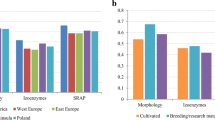Abstract
Seven F5 populations derived from Avena sativa × Avena sterilis hybrids were bulked and then sheep grazing and simulated grazing (lawn mowing) were imposed from F5 up to F10. After the 5 year, on 1100 F10 plants per treatment, determinations were performed on the following traits: growth habit at early and late tillering; number of tillers and height of young plants; height of headed plants; number of headed tillers per plant. After five generations under grazing treatments the frequency of prostrate young plants was significantly higher in sheep grazing and in lawn-mowing treatments compared to the control. Moreover, plants from both grazing treatments were found to be lower and more tillered. These results were confirmed at the end of tillering. No difference in final plant height and number of headed tillers was observed. In only five generations, sheep grazing changed the frequency of the different plant habits. A similar result, but to a lesser extent, was induced by simulated grazing. Both treatments heavily penalized the erect habit. Through this bulk method repeated for five generations integrated with two types of grazing we were able to split the start population into nine lots of F11 seeds corresponding to the 3 × 3 combinations of treatment (sheep grazing, simulated grazing, control) and juvenile growth habit (prostrate, erect, intermediate).
Similar content being viewed by others
References
Allard RW (1988) Genetic changes associated with the evolution of adaptedness in cultivated plants and their wild progenitors. J Hered 79:225–238
Baldanzi M, Benvenuti A (1994) Ricerche su ibridi spontanei tra Avena sativa L. e A. sterilis L. Quaderni Botanica Ambientale Applicata 5:103–106
Baldanzi M, Macchia M, Machetti M (2003) Selezione su ibridi naturali tra A. sativa e A. sterilis. Sementi Elette 6:40–46
Brown CM, Forsberg RA (1987) Oat. In: Fehr WR (ed) Principles of cultivar development, vol 2, crop species. Macmillan, New York, pp 295–345
Brown CM, Patterson FL (1992) Conventional oat breeding. In: Marshall HG, Sorrells ME (eds) Oat science and technology. ASA Inc, CSSA Inc Publishers, Madison, pp 613–656
Cuddeford D (1995) Oats for animal feed. In: Welch RW (ed) The oat crop. Chapman and Hall, London, pp 321–368
Gomez AA, Gomez KA (1984) Statistical procedures for agricultural research. Wiley, New York
Gupta SC, Frey KJ, Cox DJ (1986) Changes in several traits of oats caused by selection for vegetative growth rate. Plant Breed 97:222–226
Lawrence PK, Frey KJ (1975) Backcross variability for grain yield in oat species crosses (Avena sativa L. × A. sterilis L.). Euphytica 24:77–85
Marshall HG (1976) Genetic changes in oat bulk populations under winter survival stress. Crop Sci 16:9–15
McMaster GS (2005) Phytomers, phyllochrons, phenology and temperate cereal development. J Agric Sci 143:137–150
Mishra SN (1988) Oats for grazing. In: Mattson B, Lyhagen R (eds) Proceedings of the 3rd Intern. Oat conf. Lund, Svalöf, Sweden, pp 180–189
Nelson CJ (2000) Shoot morphological plasticity of grasses: leaf growth vs. tillering. In: Lemaire G, Hodgson J, de Moraes A, Nabinger C, de F Carvalho PC (eds) Grassland ecophysiology and grazing ecology. CABI, New York, pp 101–126
Scott AW, Whalley RDB (1984) The influence of intensive sheep grazing on genotypic differentiation in Danthonia linkii, D richardsonii and D. racemosa on the New England Tablelands. Austr J Ecol 9:419–429
Snaydon RW (1978) Genetic changes in pastures. In: Wilson JR (ed) Plant relations in pastures. CSIRO, Melbourne, pp 253–268
Vaylay R, van Santen E (1999) Grazing induces a patterned selection response in tall fescue. Crop Sci 39:44–51
Author information
Authors and Affiliations
Corresponding author
Rights and permissions
About this article
Cite this article
Baldanzi, M., Andreotti, L., Macchia, M. et al. Bulk method selection with grazing treatments on segregating populations from Avena sativa × A. sterilis hybrids. Euphytica 182, 405–408 (2011). https://doi.org/10.1007/s10681-011-0514-y
Received:
Accepted:
Published:
Issue Date:
DOI: https://doi.org/10.1007/s10681-011-0514-y




